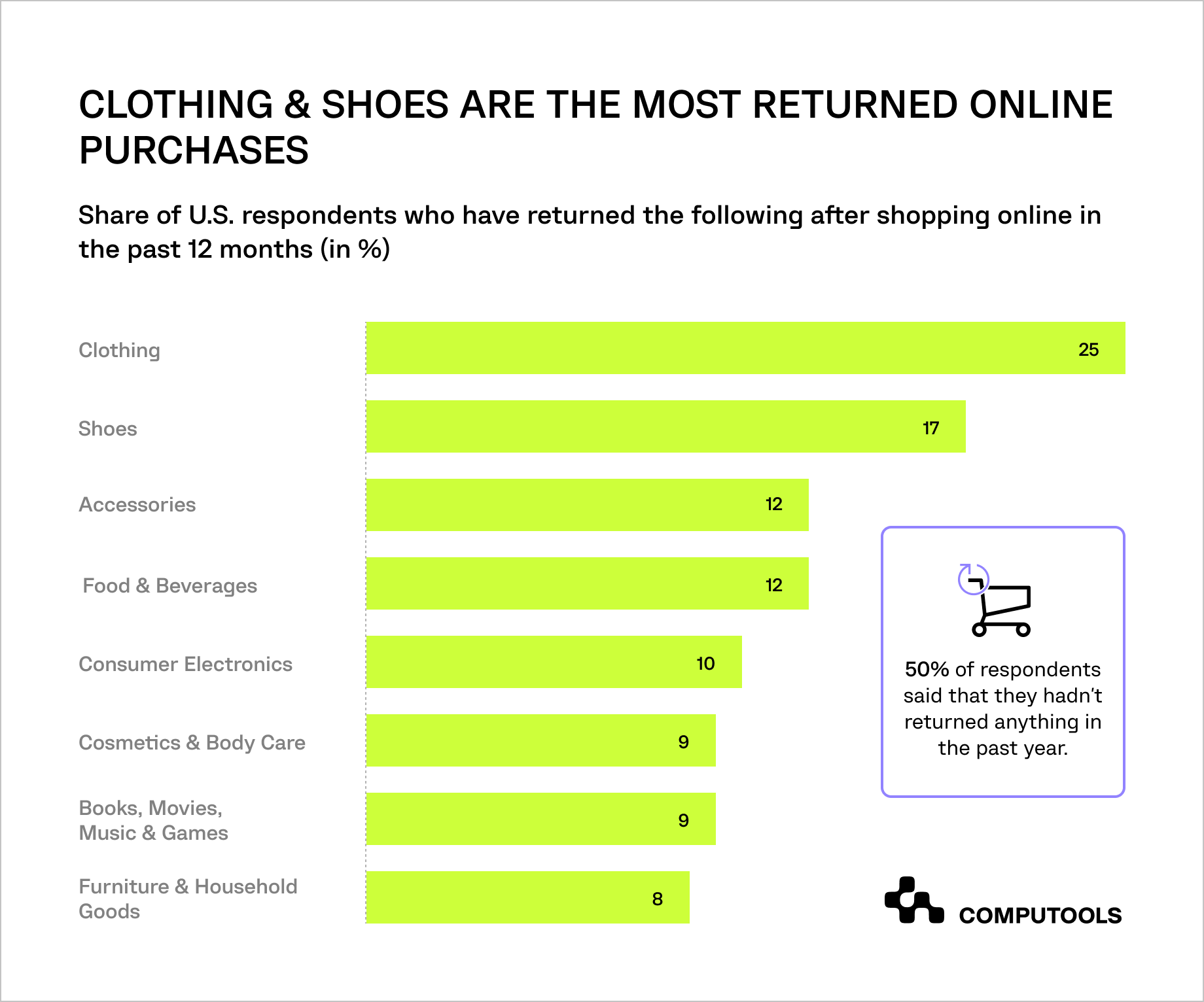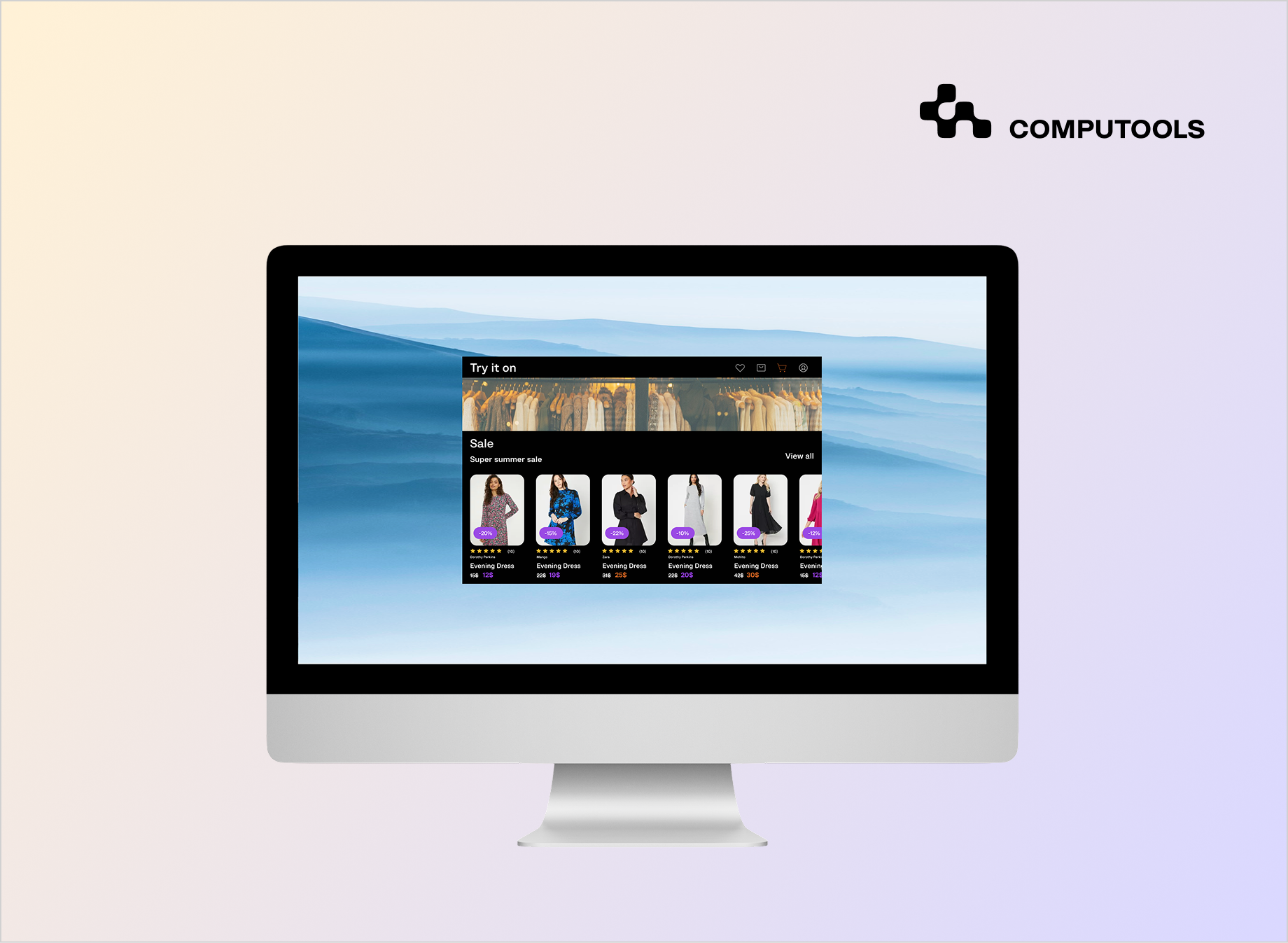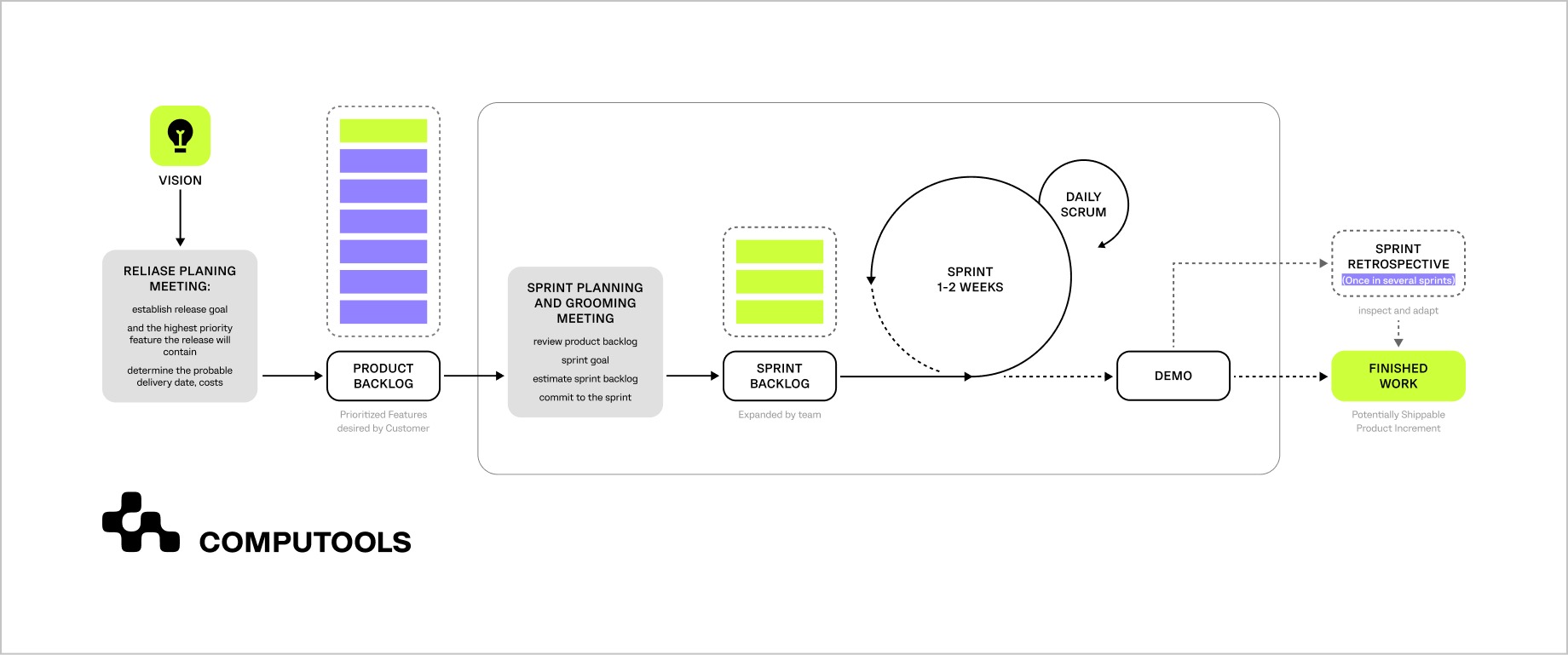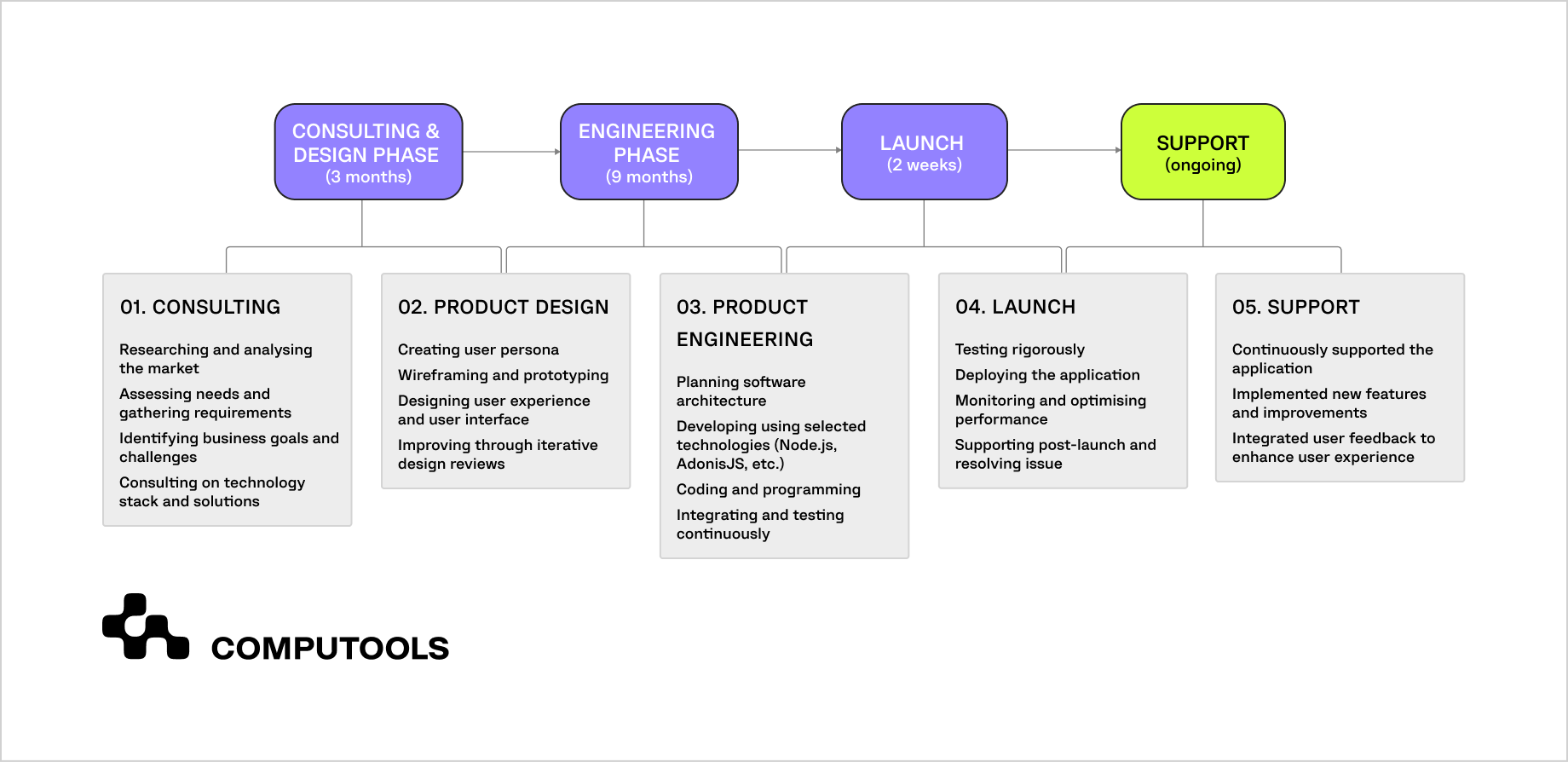Product returns are quietly affecting e-commerce margins. In 2024, the average return rate across online retailers reached 16.9%, while in fashion, it’s often much higher, between 15% and 30% for clothing and accessories. Behind these numbers lie frustrated shoppers, wasted logistics, and lost profit.
Many buyers still order two or three sizes “just in case,” knowing they can return what doesn’t fit. The scale of this problem is staggering: in the fashion sector alone, returns cost the industry around $218 billion each year.
AI try-on ecommerce offers a way out of this costly cycle, replacing guesswork with precision through computer vision, augmented reality, and machine learning that let shoppers see what fits before they buy.
Computools supports this shift through its retail software development services, helping fashion and e-commerce businesses adopt technologies that enhance personalization and customer experience. With strong expertise in fashion software development, the company engineers solutions powered by AR and computer vision to bridge the gap between physical and digital shopping.
This experience came to life in the TRY IT ON project, an AI try-on app that helped a fashion retailer cut product returns by 30% and boost online sales by 20%.

How we built an AI try-on app that cut fashion returns by 30%
A leading fashion retailer with numerous physical and online stores turned to us to solve one of the industry’s biggest challenges: growing return rates and declining customer confidence in online purchases. After store closures and the rise of e-commerce, shoppers struggled to choose the right size or style, often ordering several items “just to try.” The client needed a digital tool to replicate the fitting room experience and reduce returns without compromising user convenience.
Computools approached this challenge through its AI development services, combining computer vision, machine learning, and augmented reality into a unified system. The result was TRY IT ON, an intelligent platform that lets customers preview how clothing fits and looks on their body using only a smartphone camera. The system delivers precise visualization that builds trust and simplifies decision-making by processing real-time body proportions and garment data.
The impact was quick and clear: a 30% drop in return rates, a 20% boost in online sales, and a noticeable rise in customer satisfaction scores. Beyond the numbers, the project positioned the client as a technological innovator in the fashion industry, a brand capable of transforming challenges into a competitive advantage through digital innovation.

The TRY IT ON project proved how virtual try-on software for clothing retailers can reshape online shopping and cut costly returns. With hands-on experience in AI, AR, and data-driven retail platforms, Computools understands what it takes to turn complex technology into real business value. That’s why we’re sharing how to build an AI try-on feature for e-commerce to reduce returns step by step.
How to build an AI try-on feature for e-commerce to reduce returns
Creating a virtual try-on project involves more than connecting AI and AR. It’s about understanding body geometry, garment behavior, and user expectations, then translating them into reliable, real-time experiences that help shoppers make confident choices.
Let’s break down the nine key steps for creating an engaging AI try-on ecommerce experience.
Step 1. Set clear goals and analyze your market
Before building any AI-powered solution, start with clarity. Successful virtual try-on app development begins with a deep understanding of what problem you’re actually solving.
Are customers abandoning purchases because they can’t predict fit? Are logistics costs skyrocketing due to return handling? Or is user engagement stagnating because the shopping experience feels impersonal?
Each scenario leads to different technical and UX priorities. For instance, if size accuracy is the main issue, focus on body measurement and garment mapping precision. If customer confidence is the pain point, prioritize realism and lighting consistency in virtual renders.
Market research helps shape this strategy. Study customer behavior and expectations: what devices they use, which categories they buy most, and why they return products. Competitive analysis also reveals opportunities for faster rendering, more inclusive body types, or a smoother checkout flow.
When Computools developed TRY IT ON for a fashion retailer, we began with exactly this research. Customer data revealed that 70% of returns were size-related, and nearly half of shoppers wanted to “see themselves” in the product before purchase.
That insight defined the project’s north star: reduce product returns with AI by replicating the emotional confidence of an in-store fitting room. This goal guided every decision from how the AI model processed body data to how the interface communicated real-time fit accuracy.
Step 2. Collect and prepare training data
Every AI system relies on the quality of the data that shapes it. For virtual try-on software, the quality, diversity, and structure of the data directly influence how realistic and inclusive your try-on results will be.
• Start with high-resolution product photos captured under consistent lighting and from multiple angles. Each garment should be isolated on a transparent background to simplify segmentation and layering. Include metadata such as fabric type, elasticity, and texture. These parameters help the AI model simulate how clothing drapes or stretches across different body shapes.
• Next, gather human model images with varied poses, body proportions, and skin tones. The broader the range, the more adaptable your system becomes. Data preprocessing includes body segmentation, alignment, and normalization to create uniform image dimensions and scale. This step prevents distortions when overlaying garments during AI rendering.
Developers often rely on open-source datasets like DeepFashion, VITON, or FashionIQ to accelerate training. These contain paired images of models and garments ideal for supervised learning. Advanced projects also combine synthetic data generated through 3D modeling or photogrammetry to fill gaps where real data is limited.
When Computools built TRY IT ON, we followed a hybrid approach: integrating the client’s existing product catalog with curated model photos to train garment recognition and fit prediction modules.
We also applied automated preprocessing pipelines to detect edges, remove noise, and balance lighting, ensuring uniformity across thousands of input images. This precise data preparation was one of the key enablers of accurate AI-powered try-on technology, leading to natural garment alignment and consistent rendering across devices.
Step 3. Build AI modules for body and garment understanding
Once your data pipeline is ready, the next task is to teach the system to “see” and “understand” the human body and the garments it overlays. This stage turns raw images into structured insights using AI-based product visualization tools that combine pose detection, segmentation, and realistic rendering.
• The process starts with human pose estimation, identifying body key points and proportions. Frameworks such as OpenPose, DensePose, and MediaPipe provide pre-trained models capable of mapping complex poses and adapting to varied body types. Once the system recognizes the body’s orientation, segmentation models separate it from the background, creating a clean silhouette for garment overlay.
• Next comes garment processing and 3D fitting. Here, the model can manipulate clothing items into 2D or 3D representations. Neural networks like U-Net and GANs (Generative Adversarial Networks) perform style transfer and clothing warping — aligning fabrics with body contours, replicating natural folds, and preserving textures under different lighting conditions.
Computools used this approach to TRY IT ON to map real product images onto users’ dynamically silhouetted with high precision. The system produced realistic previews that accurately reflected fabric texture, lighting, and proportions by applying GAN-based models. This combination of AI and computer vision became the foundation of the project’s AI virtual try-on for eCommerce module. This core engine made the experience both authentic and scalable.
Step 4. Integrate AR visualization and rendering
Once the AI model understands body proportions and clothing structure, it’s time to turn algorithms into experience. This step transforms computed data into a visual interaction that users see and feel. The successful integration of augmented reality try-on for fashion depends on how smoothly the virtual garments render in real time across devices.
AR visualization relies on frameworks like Apple ARKit and Google ARCore, which track camera movement and depth to align digital clothing with the user’s body. Realism is achieved through lighting calibration, texture reflection, and responsive motion tracking. When paired with optimized neural rendering, AR ensures that every fabric fold and color shift responds naturally as the user moves.
In TRY IT ON, Computools embedded AR capabilities directly into the mobile interface, creating a seamless bridge between advanced AI modules and intuitive UX. Customers could rotate their on-screen reflection, switch outfit colors, or zoom in on texture details rendered in real time. The focus wasn’t just on visual accuracy but emotional authenticity, the feeling that what users saw on-screen represented how they would look offline.
This stage also demanded a delicate balance between performance and realism. Computools’ engineers used adaptive rendering pipelines and GPU-based optimization to maintain smooth frame rates while preserving high visual fidelity. The result was responsive, photorealistic fittings that made online shopping feel immediate, engaging, and trustworthy.
Step 5. Develop a secure and scalable backend
Even the most advanced AI models are useless without a stable system behind them. The backend development determines whether your virtual try-on experience feels seamless or collapses under real-world load. It must manage large volumes of visual data, synchronize AI outputs, and deliver instant responses to thousands of concurrent users.
When building Virtual fitting room solutions, the focus is on speed, scalability, and data protection. Computools’ engineers designed the TRY IT ON architecture using Node.js, AdonisJS, and GraphQL to ensure efficient communication between the AI core, AR renderer, and mobile interface. MySQL supported the structured storage of product catalogs, user sessions, and fitting results.
Security approach was treated as a first-class feature: encrypted APIs, secure authentication, and continuous monitoring safeguarded personal and payment data. This solid backend foundation made TRY IT ON perform reliably, replicating the responsiveness of an in-store experience within a digital ecosystem.
Step 6. Personalize the experience with AI
Once the core functionality is in place, personalization turns technology into a connection.
Modern shoppers expect every interaction to reflect their preferences, not just generic recommendations. Effective AI personalization in eCommerce allows retailers to adapt product suggestions, colors, and sizing guidance based on real user behavior, purchase history, and fit data.
Personalization became a crucial part of the retention strategy in TRY IT ON. The system analyzed each user’s fitting sessions to recommend styles and sizes that matched their comfort patterns. Returning shoppers received curated outfit suggestions aligned with their previous choices, a digital equivalent of a stylist who remembers their taste.
This approach increased engagement and trust: users explored outfits more because the app felt genuinely “aware” of their style identity. For the client, it translated into repeat visits, fewer abandoned carts, and stronger brand loyalty. Personalization transformed the AI model from a static fitting tool into an evolving shopping companion.
Step 7. Optimize, test, and deploy
No AI system is ever perfect at launch. Precision and performance are built through iteration. Comprehensive testing ensures the virtual try-on model performs consistently across devices, lighting conditions, and network speeds. Performance audits verify rendering speed, fit accuracy, and data integrity under real-world load.
At Computools, optimization is a continuous process built on user analytics and automated testing pipelines. Each sprint cycle includes A/B tests to evaluate visual realism, latency, and recommendation quality. Metrics such as SSIM (Structural Similarity Index) and FID (Fréchet Inception Distance) help measure how closely generated try-on visuals resemble real garments.
In TRY IT ON, iterative testing revealed subtle insights into how users interacted with 3D rotations and which backgrounds caused model misalignment. These findings led to better lighting normalization and faster rendering without compromising quality. After multiple test rounds, the app achieved smooth performance across iOS and Android, ensuring a reliable launch.
Rigorous optimization turned TRY IT ON into more than a functioning prototype; it became a scalable retail solution capable of handling high traffic while maintaining photorealistic precision.
Step 8. Measure ROI and scale
After deployment, success should be measured by downloads or session length, clear business outcomes, higher conversions, lower returns, and stronger customer retention. To evaluate impact, track metrics like return-rate reduction, average order value, session duration, and repeat-purchase ratio. These numbers reveal how well the virtual try-on experience influences buyer confidence and operational efficiency.
In TRY IT ON, Computools evaluated performance over a period after launch. The app achieved a 30% drop in returns and a 20% increase in online sales, proving that technology investments directly translated into measurable ROI. For the client, it also improved logistics efficiency by reducing reverse-shipping costs and warehouse processing times.
Such results highlight the broader role of AI in fashion retail technology, transforming creative vision into predictable revenue. Once the foundation is proven, scaling becomes straightforward: expand to new product categories, integrate more body types, or introduce 3D garment scanning. The combination of reliable architecture and modular AI design ensures growth without compromising stability or realism.
Step 9. Keep innovating your AI try-on Ecommerce app
AI and AR in retail evolve faster than consumer habits; what feels cutting-edge today will be the new standard tomorrow—staying competitive means constant experimentation, integrating new data types, and refining user experience.
Modern AR try-on solutions for online stores already go beyond simple garment overlays. Emerging tools combine 3D body reconstruction, depth mapping, and real-time fabric simulation to make fittings indistinguishable from reality. Retailers adopting these advancements early gain a tangible edge: higher engagement, better inclusivity, and stronger customer trust.
At Computools, innovation is treated as an ongoing process. Insights from TRY IT ON continue to inform new R&D initiatives, from improving model generalization across diverse body shapes to developing faster rendering for web-based try-ons. Each iteration brings the industry closer to a frictionless shopping experience where technology quietly amplifies human intuition rather than replacing it.
The virtual fitting room of the future forms the basis of how consumers will engage with fashion in the digital era.
The fashion industry is evolving faster than ever as AI drives design, production, and customer experience innovation. Learn more about how artificial intelligence is reshaping the sector of AI in Fashion: Revolutionising the Industry Trends.

The rise of virtual try-on technology for online shopping marks a turning point in how customers interact with fashion brands. It bridges the gap between inspiration and purchase, returning confidence to digital retail. It means measurable gains for companies, lower return rates, stronger customer loyalty, and more innovative inventory planning.
At Computools, we view AI and AR not as fleeting trends, but as essential tools for creating long-term business value. Our experience with TRY IT ON proves that innovation in e-commerce works best when grounded in real needs, robust engineering, and user empathy. The next generation of shopping experiences will belong to those who make technology feel effortless and truly personal.

Join the leading brands cutting returns by up to 30% and transforming shopper hesitation into confident purchases with AI-powered try-on technology.
Real-world success stories with AI try-on tools
Leading brands worldwide demonstrate that virtual try-on technology is more than just a novelty; it’s a proven driver of engagement, confidence, and profitability.
• Global beauty leader Sephora introduced Virtual Artist, an AR- and AI-based makeup tool that lets customers use smartphone cameras to test products directly on their faces. This initiative became one of the earliest large-scale examples of AI-powered fitting solutions for eCommerce in the beauty industry.
As a result, customer engagement and conversion rates soared, while shoppers reported greater confidence in choosing the right products. The brand also recorded a noticeable decline in return volumes and a rise in overall profitability, proving that immersive technology can directly influence purchasing behavior.
• FFFACE Studio partnered with Makeup by Mario to develop a real-time try-on experience directly integrated into the brand’s website. Before purchasing, users could preview lipsticks, foundations, and eyeshadows in true-to-life lighting.
This project illustrates how eCommerce virtual try-on feature development can turn ordinary browsing into a personalized shopping experience.
• Sportswear giants Nike and Adidas adopted AR and AI-powered fitting rooms to help customers find the right size and fit online. Nike’s app scans the user’s foot via smartphone to recommend precise shoe sizes, while Adidas introduced virtual try-ons for apparel.
These technologies improved fit accuracy, reduced return rates, and deepened consumer trust, showing how data-driven innovation translates directly into operational efficiency and stronger customer loyalty.
• L’Oréal’s acquisition of ModiFace positioned the company as a pioneer of digital beauty. Customers can virtually test cosmetics and hair colors in real time through AR mirrors, mobile apps, and social media filters.
This approach increased purchase confidence, drove more traffic across multiple channels, and led to consistent growth in online beauty sales. By seamlessly integrating AI with aesthetics, L’Oréal established a new standard for personalization and inclusivity in e-commerce.
• The Israeli startup Uturn.shop reimagines product returns through a peer-to-peer resale model powered by AI. Integrated with Shopify, customers can resell returned items locally before they reach warehouses. This approach shortens the return cycle, cuts logistics costs, and reduces waste, helping retailers capture lost value and deliver a more sustainable, customer-centric post-purchase experience.
• Mainstream retailers like Zara and Warby Parker have also embraced AR and AI to elevate customer experience. Zara’s in-store AR mirrors and Warby Parker’s virtual eyewear app allow customers to preview products instantly, merging the convenience of e-commerce with the tangibility of in-store shopping. Both brands report improved engagement and higher conversion rates, demonstrating how virtual try-on tools are now essential for any brand bridging digital and physical retail.
These cases demonstrate that AI and AR are transforming e-commerce across industries, not as mere add-ons, but as vital tools for personalization, customer retention, and sustainable growth.
Virtual try-on is only one example of how fashion brands are transforming through digital technology. Learn more about the teams shaping this future in the Top 20 Fashion & Apparel Software Development Companies Worldwide.
Why partner with Computools
Choosing the right technology partner determines whether innovation becomes a prototype or a profit engine. Computools brings proven expertise in retail innovation, helping brands move from concept to scalable reality through advanced eCommerce development services.
Our team combines AI, AR, and UX design to deliver personalized shopping experiences that drive measurable ROI. With projects like TRY IT ON, we’ve shown how AI for reducing fashion eCommerce returns can transform customer satisfaction and operational efficiency, turning uncertainty into confidence and loyalty.

Every eCommerce software solution we build is designed for performance, security, and scalability. Computools engineers apply Agile practices, ISO-certified processes, and data-driven QA to ensure reliability across markets and platforms.
As retail moves toward hyper-personalization, our digital try-on tools for fashion retailers help brands stay ahead by merging computer vision, AR visualization, and analytics into seamless customer experiences.
To discuss your project or explore collaboration, write to us at info@computools.com.
Conclusion
AI and AR have shifted from testing to real-world application, transforming how people shop, select, and trust brands online. Online shopping AI try-on tools connect curiosity with confidence, helping customers make informed choices and giving retailers insights that drive measurable growth.
It means fewer returns, smarter inventory, and stronger loyalty for businesses. Shopping is transforming, becoming more personal, intuitive, and human again.

Computools
Software Solutions
Computools is a digital consulting and software development company that delivers innovative solutions to help businesses unlock tomorrow.









“Computools was selected through an RFP process. They were shortlisted and selected from between 5 other suppliers. Computools has worked thoroughly and timely to solve all security issues and launch as agreed. Their expertise is impressive.”